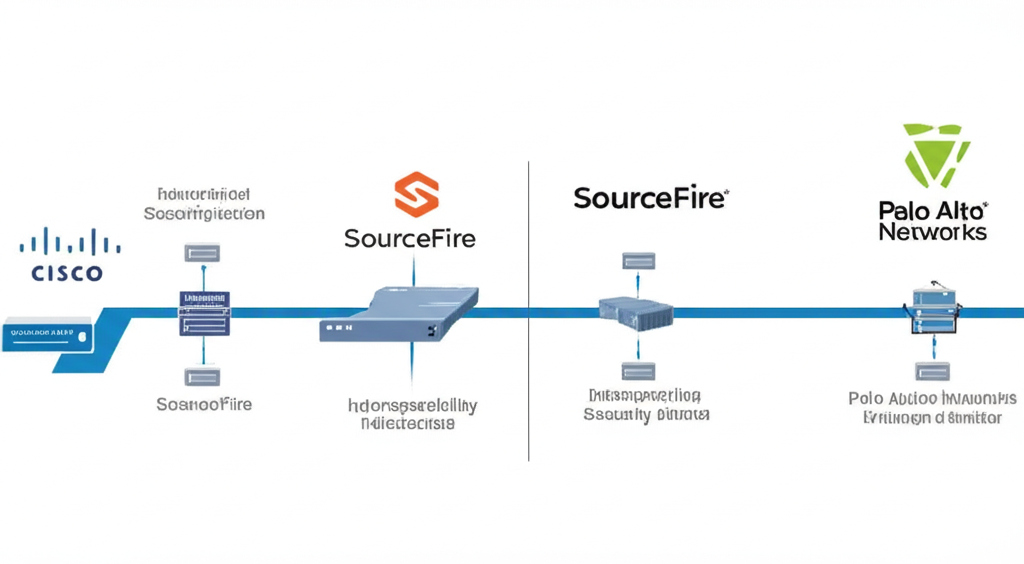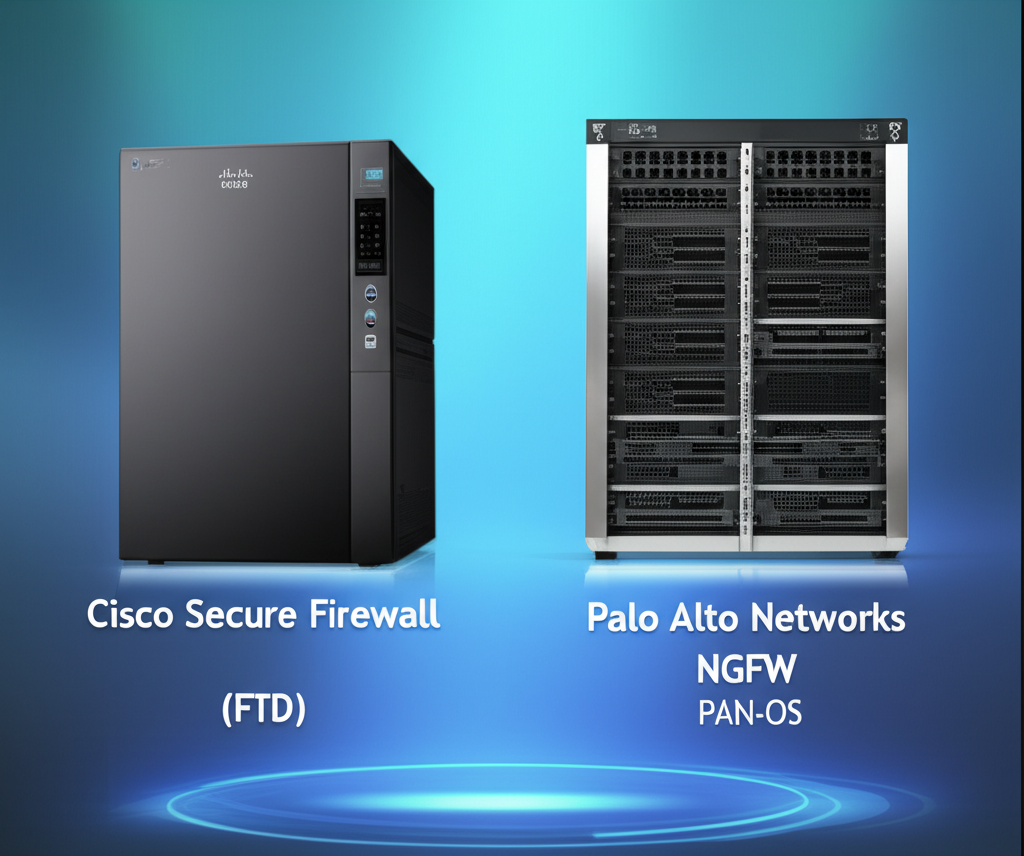Introduction: Decoding the Relationship Between Cisco and Palo Alto Networks

In today’s complex enterprise security environment, few names carry as much weight as Cisco and Palo Alto Networks. These two industry leaders have shaped the evolution of network protection, each bringing a distinct philosophy to the table. While frequently positioned as rivals—especially in the high-stakes arena of Next-Generation Firewalls (NGFWs)—their relationship is far from one-dimensional. Beyond competition lies a growing recognition of interoperability, driven by real-world demands for flexible, multi-vendor security architectures. Organizations no longer ask simply which vendor to choose, but how to leverage strengths from both. This article dives deep into the strategic, technical, and operational realities of navigating Cisco and Palo Alto Networks solutions, offering a clear-eyed comparison of their core offerings, integration capabilities, and long-term value.
A Brief History of Cisco-Palo Alto Interactions

Cisco’s dominance in networking laid the foundation for its strategic move into cybersecurity. Historically rooted in routing and switching, Cisco expanded its security portfolio through key acquisitions—most notably Sourcefire in 2013—which brought advanced intrusion prevention and the Firepower platform into its fold. This marked a deliberate shift toward embedding security within its vast infrastructure ecosystem. Around the same time, Palo Alto Networks emerged as a disruptor, redefining firewall capabilities with its application-aware, identity-driven approach. By pioneering the concept of the Next-Generation Firewall, Palo Alto shifted the paradigm from port-and-protocol-based rules to intelligent, context-aware policies.
Though their paths are often competitive, collaboration has become increasingly relevant. As enterprise networks grow more heterogeneous, customers demand solutions that work together—not in isolation. Over time, both vendors have introduced integration points, allowing their platforms to exchange threat intelligence, share user context, and coexist within broader security operations centers (SOCs). These interoperable features reflect a market reality: many organizations run hybrid environments, combining Cisco’s network reach with Palo Alto’s precision security.
Cisco Secure Firewall vs. Palo Alto Networks NGFW: A Head-to-Head Comparison

At the heart of the enterprise firewall debate lies a direct contest between Cisco Secure Firewall and Palo Alto Networks’ NGFW platform. Both deliver robust protection, but their underlying design principles, operational models, and integration strategies differ significantly. Understanding these distinctions is essential for any organization evaluating its long-term security posture.
Architectural Differences: Firepower Threat Defense (FTD) vs. PAN-OS

Cisco’s Secure Firewall, powered by Firepower Threat Defense (FTD), evolved from the legacy Adaptive Security Appliance (ASA) platform. While FTD unified firewall, IPS/IDS, and application visibility into a single software image, its architecture retains elements of modular processing. Security functions such as intrusion prevention, malware detection, and URL filtering operate as distinct services, often requiring multiple inspection passes. This model benefits from deep integration with Cisco’s broader network stack—routers, switches, SD-WAN, and ACI—enabling rich telemetry and contextual awareness across layers.
Palo Alto Networks took a different path. PAN-OS was built from the ground up as a true next-generation platform, centered on a “single-pass parallel processing” engine. In this model, every packet is analyzed once for application identity, user context, content, threats, and URLs—all simultaneously. This eliminates redundant inspections, reducing latency and maintaining consistent performance even under full security load. The result is a streamlined, high-throughput architecture optimized for environments where speed and precision matter most. This foundational difference—modular evolution versus purpose-built innovation—shapes how each platform enforces policy, scales under load, and integrates with surrounding systems.
Key Feature Comparison: Threat Prevention, Application Control, and User-ID
Both vendors provide comprehensive security capabilities, but the depth, consistency, and native integration of features vary.
| Feature Category | Cisco Secure Firewall (FTD) | Palo Alto Networks NGFW (PAN-OS) |
|---|---|---|
| Threat Prevention (IPS/IDS) | Advanced Snort-based IPS/IDS with extensive signature database, behavioral analysis, and Snort 3 engine. Integrates with Cisco Talos threat intelligence. | High-performance IPS with signature-based, protocol anomaly, and heuristic detection. Leverages WildFire (cloud-based malware analysis) and Threat Prevention service. |
| Advanced Malware Protection (AMP) | Cisco Secure Malware Analytics (formerly AMP Threat Grid) for sandboxing, file reputation, and retrospective security. | WildFire for cloud-based threat analysis, sandbox detonation, and dynamic signature generation. Integrates with file blocking profiles. |
| Application Control (App-ID) | Application Visibility and Control (AVC) for granular application identification and policy enforcement. | Industry-leading App-ID engine identifies applications regardless of port, protocol, or evasive tactics, enabling precise policy enforcement. |
| User Identification (User-ID) | Integrates with Cisco Identity Services Engine (ISE), Active Directory, LDAP for user-based policies. | User-ID maps users/groups to IP addresses using various methods (AD integration, syslog, agentless), enabling user-aware policies. |
| URL Filtering | Cisco Talos-powered URL filtering with extensive categories and reputation-based blocking. | URL Filtering service with over 100 categories, custom URL lists, and real-time analysis for malicious sites. |
| VPN Capabilities | Robust AnyConnect VPN for remote access (SSL/IPsec), site-to-site IPsec VPN. | Strong GlobalProtect VPN for remote access (SSL/IPsec), site-to-site IPsec VPN, and SD-WAN capabilities. |
Cisco’s ecosystem strength lies in cross-platform synergy—its ability to correlate network behavior from routers and switches with firewall logs for enhanced detection. Palo Alto, by contrast, treats application and user identity as first-class citizens in its policy framework, making enforcement more intuitive and less reliant on complex rule stacking.
Performance and Scalability Metrics
Performance under real-world conditions is a critical differentiator. Cisco offers a broad range of physical and virtual appliances, from compact branch devices to high-density data center models. Recent hardware generations have been optimized for FTD workloads, delivering competitive throughput for both basic firewall and full-featured threat inspection. Virtual deployments (Virtual FTD) support hybrid and multi-cloud use cases, though performance can vary depending on hypervisor and resource allocation.
Palo Alto Networks consistently emphasizes performance predictability. Thanks to its single-pass architecture, throughput remains stable even when all security services—IPS, WildFire, URL filtering, and SSL decryption—are enabled. This is particularly valuable in high-traffic environments where latency can impact user experience. The VM-Series extends this consistency into virtualized and cloud environments, while the CN-Series and Prisma Cloud provide cloud-native security for containerized and Kubernetes workloads. For organizations seeking real-world performance benchmarks, Gartner Peer Insights offers detailed user feedback and comparative insights across multiple vendors and deployment scenarios.
Management and Orchestration: Cisco FMC vs. Palo Alto Networks Panorama
Centralized management is not just a convenience—it’s a necessity for large-scale deployments. Cisco’s Firepower Management Center (FMC) serves as the control plane for Secure Firewalls, enabling policy management, event monitoring, reporting, and integration with other Cisco security tools like Secure Endpoint and Secure Network Analytics. FMC provides a unified view within Cisco’s ecosystem, but its interface has historically been criticized for complexity, especially for teams new to the platform.
Panorama, Palo Alto’s centralized management solution, is widely praised for its clean, intuitive interface and consistent user experience. It supports hierarchical policy management through device groups and templates, making it easier to scale policies across thousands of firewalls. Panorama also integrates seamlessly with Cortex XDR, Prisma Access, and Prisma Cloud, enabling coordinated response across endpoints, networks, and cloud environments. Its API-first design facilitates automation and orchestration, reducing manual configuration errors and improving operational efficiency.
Strategic Alliances and Integration Points: When Cisco and Palo Alto Work Together
Despite competing head-to-head, many enterprises deploy both Cisco and Palo Alto Networks solutions. Rather than viewing them as mutually exclusive, forward-thinking organizations leverage integration points to build stronger, more adaptive security postures.
Cisco Secure Access and Palo Alto Firewall Integration
Cisco Secure Access (formerly ISE) is a leading Network Access Control (NAC) platform that enforces policies based on user identity, device type, and compliance status. When integrated with Palo Alto firewalls, ISE can pass rich contextual data—such as user group membership, device posture, and vulnerability status—directly to the firewall via APIs or syslog. This allows Palo Alto NGFWs to apply dynamic, identity-aware rules that go beyond traditional IP-based filtering. For example, a user connecting from a non-compliant device could be automatically placed in a restricted security zone, regardless of location. This fusion of Cisco’s access control expertise with Palo Alto’s granular enforcement creates a powerful, layered defense strategy.
Palo Alto Networks Panorama Integration with Cisco Security Solutions
While Panorama manages Palo Alto firewalls exclusively, it can feed telemetry into a Cisco-centric security operations environment. Security logs, traffic flows, and threat events from Palo Alto devices can be exported to Cisco Secure Network Analytics (Stealthwatch) or Cisco SecureX for centralized correlation and analysis. This enables security teams to maintain visibility across a mixed-vendor network, detecting lateral movement or command-and-control activity that might otherwise go unnoticed. Additionally, Cisco SecureX can use APIs to trigger actions in Panorama—such as quarantining a compromised host—based on alerts from Cisco’s detection systems.
Palo Alto Networks Cortex XDR and Cisco Security Solutions
Cortex XDR excels at aggregating and correlating data across endpoints, networks, and cloud workloads. It supports ingestion from third-party sources, including Cisco’s ecosystem. Network flow data (NetFlow/IPFIX) from Cisco switches, logs from Cisco Secure Endpoint, or alerts from Cisco Secure Email Gateway can all be fed into Cortex XDR. By combining this telemetry with its own detection engines, Cortex XDR can identify multi-stage attacks that span different vendors’ domains. For instance, an email phishing attempt detected by Cisco Secure Email could be linked to a later C2 beacon observed by a Palo Alto firewall, enabling faster investigation and response.
Palo Alto Firewall Integration with Cisco ACI
In data centers using Cisco Application Centric Infrastructure (ACI), automation and policy-driven networking are central. Palo Alto Networks offers integration with ACI through its VM-Series and physical firewalls, allowing security policies to be dynamically aligned with application workloads. Using APIs, the ACI Application Policy Infrastructure Controller (APIC) can inform the firewall about Endpoint Groups (EPGs) and application tiers, enabling automated insertion of security services. This ensures that as applications scale or migrate within the fabric, associated firewall policies follow them—maintaining segmentation and compliance without manual intervention. This level of integration is crucial for organizations that want the agility of SDN without sacrificing security enforcement.
The User’s Perspective: Migration, Challenges, and Best Practices
Choosing between Cisco and Palo Alto is rarely a greenfield decision. Many organizations face migration challenges when transitioning from one platform to another—or when integrating both into a cohesive strategy.
Real-World Scenarios: When to Choose Which Platform
The decision often hinges on existing infrastructure, team expertise, and long-term goals.
* **Opt for Cisco Secure Firewall if:**
* Your environment is heavily invested in Cisco networking—routers, switches, SD-WAN, or ACI—and you value seamless integration.
* You already use Cisco SecureX, Secure Endpoint, or ISE and want unified visibility and orchestration.
* Your team has deep familiarity with ASA or FTD, reducing training time and operational risk.
* You prefer a single-vendor approach for procurement, support, and licensing simplification.
* **Opt for Palo Alto Networks NGFW if:**
* You need fine-grained, identity- and application-based policies that are easy to manage at scale.
* Advanced threat prevention—especially zero-day detection via WildFire—is a top priority.
* You manage a large, distributed firewall fleet and require a centralized, user-friendly management platform like Panorama.
* Your operations span hybrid or multi-cloud environments and demand cloud-native security solutions.
* You’re adopting a best-of-breed strategy and want a vendor known for innovation in NGFW and XDR.
There’s no universal winner. The right choice aligns with your technical landscape, risk tolerance, and operational capacity.
Understanding Total Cost of Ownership (TCO) and Licensing Models
Evaluating cost goes beyond sticker price. Total Cost of Ownership (TCO) must account for hardware, software subscriptions, support, training, and internal labor.
| TCO Factor | Cisco Secure Firewall | Palo Alto Networks NGFW |
|---|---|---|
| Hardware Cost | Competitive, often bundled with broader Cisco infrastructure deals. | Generally higher initial hardware cost for comparable throughput. |
| Licensing Model | Smart Licensing, often bundled in software subscriptions (e.g., Threat Defense, Secure Endpoint). Tiered feature bundles. | Subscription-based for advanced features (Threat Prevention, WildFire, URL Filtering, GlobalProtect). Often bundled for comprehensive protection. |
| Support Costs | Cisco Smart Net Total Care (SNTC) or Solution Support, tiered based on service level. | Palo Alto Networks Premium Support, tiered based on service level and response times. |
| Operational Expenses (OpEx) | Can be complex due to integration with broader Cisco ecosystem; potential for higher training costs if new to FTD. Automation capabilities with FMC. | Streamlined management with Panorama can reduce operational overhead; intuitive interface often lowers training burden. Automation via APIs. |
| Hardware Refresh Cycle | Typically 3-5 years, influenced by performance demands and software support. | Typically 3-5 years, influenced by performance demands and software support, and subscription renewals. |
| Hidden Costs | Additional modules, integration complexity, specific consulting for optimization. | Potential for needing higher-end models to maintain performance with all features enabled, cloud integration costs. |
Cisco’s licensing can become complex, especially when combining legacy ASA features with new FTD capabilities. Palo Alto’s model is generally more transparent, with bundled subscriptions (e.g., Advanced Threat Prevention) that include multiple services. However, these subscriptions represent a larger portion of ongoing costs. A thorough TCO analysis over 3–5 years—factoring in scalability, support, and internal resource allocation—is essential. For guidance on evaluating software TCO, Forrester’s analysis on TCO for software and subscriptions offers a structured framework for decision-makers.
Conclusion: Making an Informed Decision for Your Security Posture
The decision between Cisco Secure Firewall and Palo Alto Networks NGFW is not merely technical—it’s strategic. Both platforms deliver enterprise-grade security, but their strengths reflect different priorities. Cisco shines in environments where network and security must operate as a unified system, offering deep integration and operational synergy across a broad portfolio. Palo Alto Networks stands out for organizations that demand precision, simplicity, and innovation—particularly in application-aware policy enforcement and advanced threat prevention.
Modern security isn’t about picking one over the other; it’s about understanding how they can coexist and complement each other. Whether you’re planning a full migration, evaluating a new deployment, or managing a hybrid environment, success depends on assessing not just features, but integration potential, operational impact, and long-term costs. By aligning technology choices with business objectives, infrastructure realities, and team capabilities, organizations can build a resilient, adaptable security foundation—regardless of the vendor mix.
Frequently Asked Questions (FAQs)
1. Is Palo Alto Networks better than Cisco for network security?
Neither vendor is definitively “better” across the board; it depends on specific organizational needs. Palo Alto Networks is often lauded for its pioneering NGFW capabilities, granular App-ID, and WildFire threat intelligence. Cisco offers deep integration with its vast networking portfolio, making it a strong choice for existing Cisco environments and broader security ecosystems. The “better” solution is the one

留言